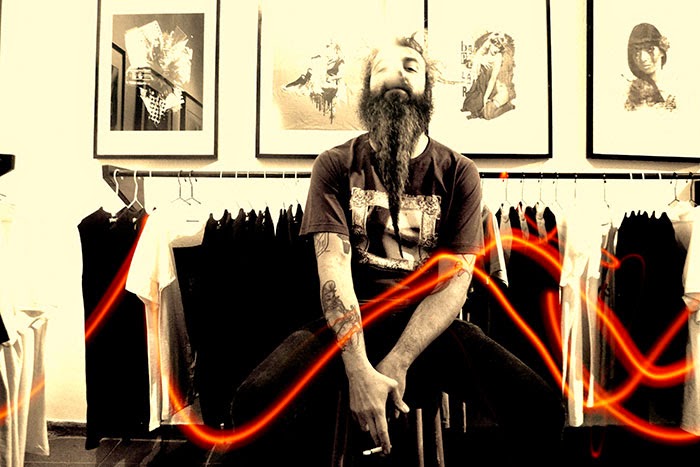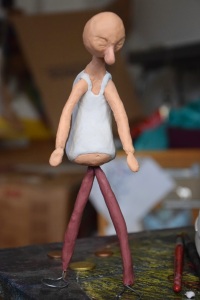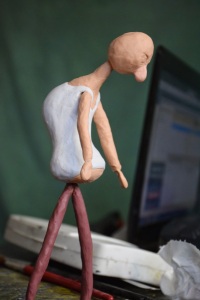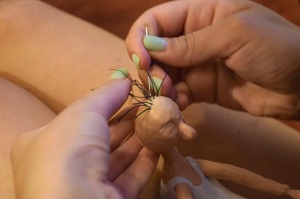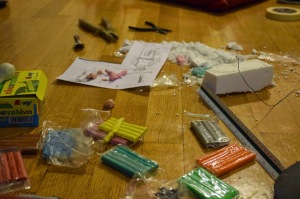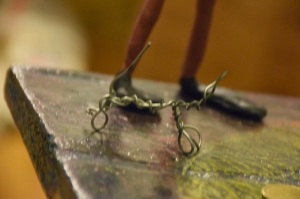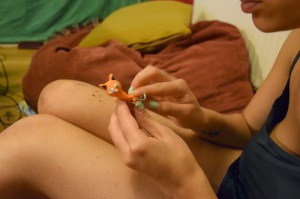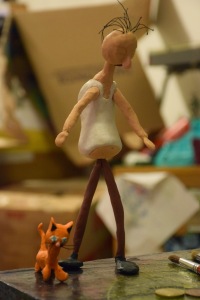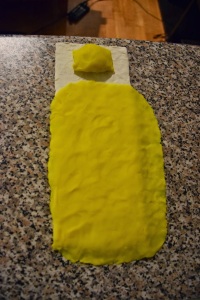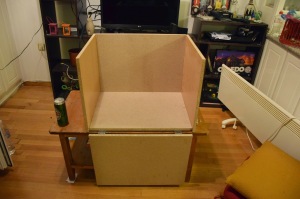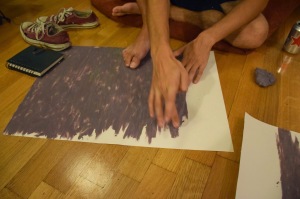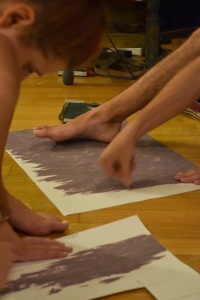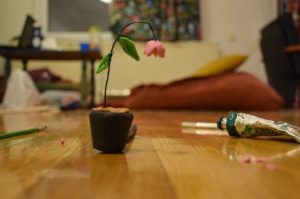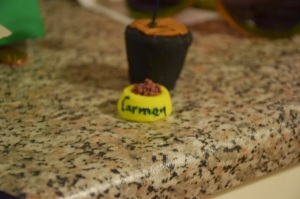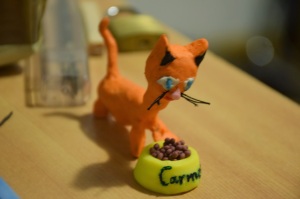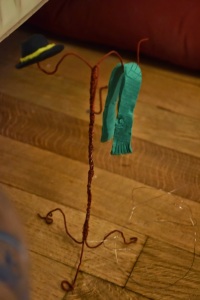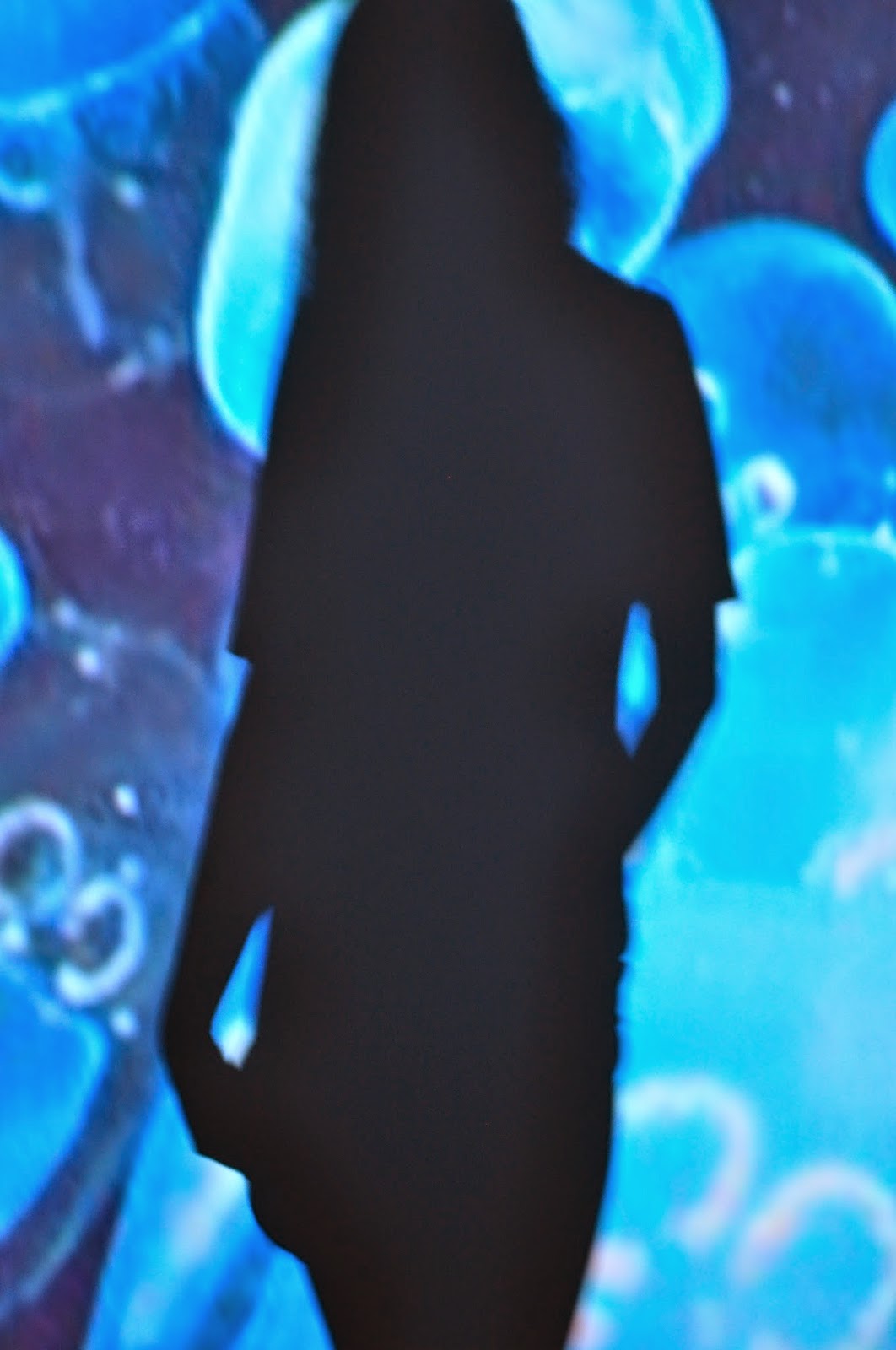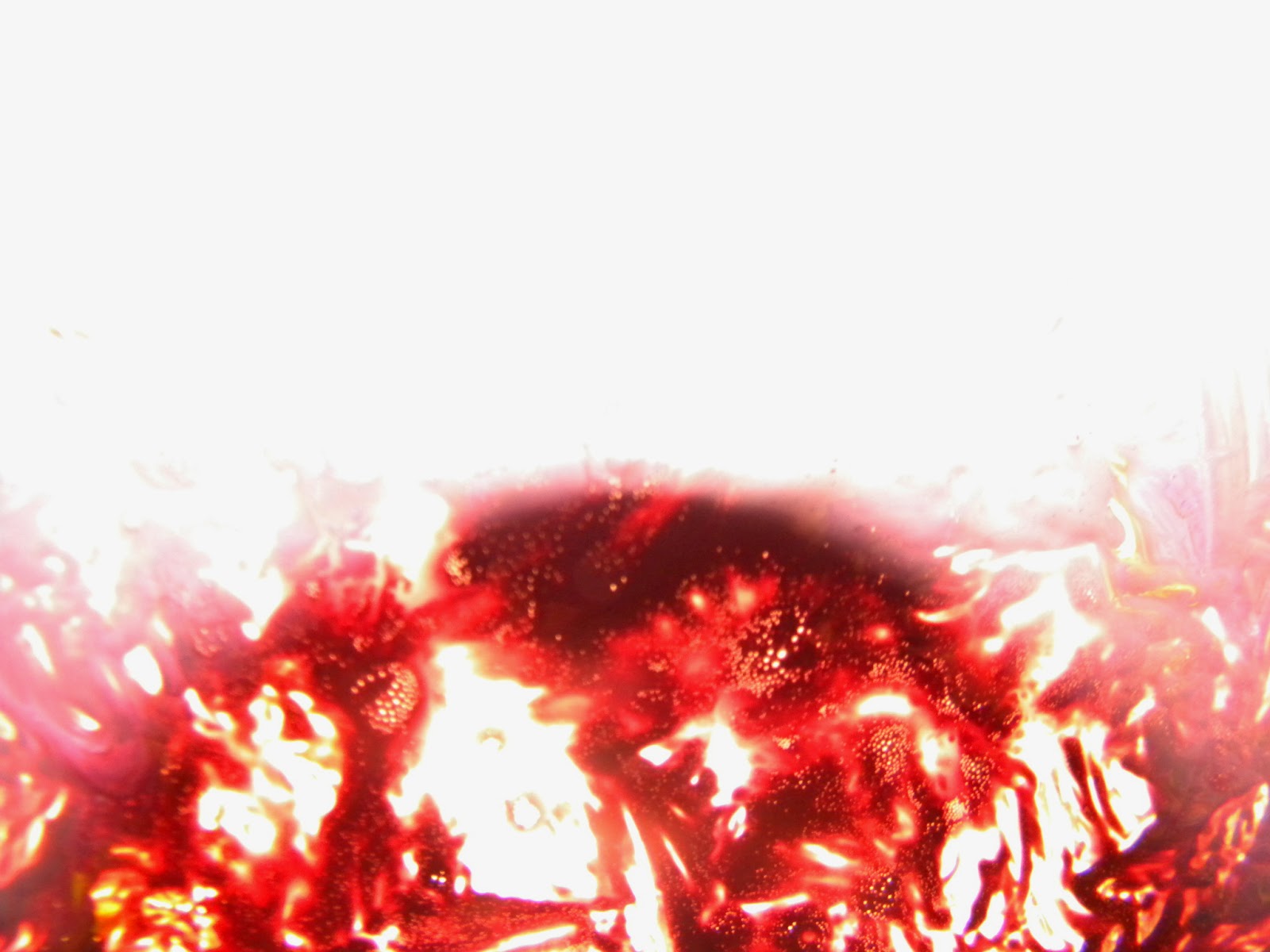[youtube https://www.youtube.com/watch?v=UXKNuWtXZ_U]
2 Μαρτίου 2015
16 Φεβρουαρίου 2015
12 Φεβρουαρίου 2015
Fact, Fiction and Truth: Contemporary Portraits
|
Fact, Fiction and Truth: Contemporary PortraitsOrganized by Susan Hoeltzel
September 19 – December 16, 1995
|
||||||||||||||||||||||||
 Tatiana Parcero
Interior Cartography, 1994 |
||||||||||||||||||||||||
| Fact, Fiction and Truth: Contemporary Portraits examines the work of fourteen photographers, including two teams—whose art explores the nature of photographic truth. From family snapshots to driver’s license photo l.D.’s, pictures of people are among photographic most common subjects. For most of us they are also a concrete representation of our memories and tangible records of our past. Sufficient to rival the painted portrait in the 19th century, photographic portraiture from the time of its invention has been closely allied to the documentary tradition—creating a sense that it is in some way replicating the experience of seeing and faithfully recording the sitter. By capturing the external visage and with it an implied glimpse at the inner self, it presumes an impossible objectivity. The photographic portrait, whether shot with a camera or created on the computer, is a chimera—an image captured in light and time, completed by inference, closure, and projection in the mind of the viewer.
In an age when direct experience can be convincingly simulated and infotainment merges with the evening news, fact and fiction become more difficult to disentangle. In this exhibition some photographers vigorously investigate the artifice of photography with a clear awareness that the image is an untrustworthy representation—some with a deadpan acknowledgment of the irony involved. In the work of others, deviation from reality provides a metaphor through which to better understand the world. The works employ a full range of technical possibilities—from computer imaging to toy cameras. In all the works there is an awareness of the medium’s ability to show more than a surface.
At first glance Keith Cottingham’s portraits of adolescent boys who bear a strong family resemblance, seem to be the most traditional work in the exhibition. Placed against a black background, the waist-length figures seem stark yet familiar. On closer inspection there is something odd about them. These are not real children but “fictitious portraits” fabricated on the computer. The portraits are an amalgam of drawing, sculpted clay modeling and a sampling of eyes, hair, and skin tones from a range of individuals of various ages, genders and ethnic backgrounds. Digitally produced these children exist only in the photograph. They are all the more disturbing because they are not lifeless, but, in fact, appear to have a personality, an attitude—they could live next door.
More disturbing in appearance are Aziz + Cucher’s unearthly portraits of individuals and couples. Their mixture of truth and fiction confound some of the basic underlying assumptions about the nature of photography as a record. Created by digitally removing some of the subjects’ facial features—eyes, mouths, nostrils—then “grafting” skin in their place, these large, color-saturated Ektachrome portraits, photographed against stark backgrounds, simultaneously document each freckle and pore. They are a contradictory blend—real yet not human. Anthony Aziz and Sammy Cucher have created subjects who have limited means of interaction with the world. It is hard to know what these droid-like people are thinking—the viewer’s traditional mechanisms for reading the sitter’s mood or intent are also gone. They seem remote and alien.
Projection and closure play a role in finding a human face in the colorful, abstract blobs of plastic photographed in Laurie Simmons and Allan McCullum’s series, Actual Photographs. These improbable portraits, based on the faces of train set figurines which stand a half inch tall, have been captured with the aid of a medical microscope. While they provide a lighter take on portraiture, they also probe the innate tendency to find the human face in the sketchiest of details.
The blurted, highly animated subjects of Barbara Pollack are in essence “found” photographs. Captured with aging or damaged Polaroid cameras, Barbara Pollack’s Cibachrome Head Shots exploit the limitations of simple point and shoot cameras. The resulting images depict subjects outside the optimal circumstances—a four foot range, in a well-lighted setting, against a middle-gray ground—and document the effects of under-lighting and its resulting record of motion. Pollack focuses her attention on the “out-takes” or what might in the normal course of events be a discarded photo. In these portraits the distortions amplify and animate the sitters in unexpected ways.
Gary Schneider’s oddly lighted subjects appear to exist on multiple planes within the print. They are “painted with light” in total darkness—the result of long exposure times, during which the camera records changes in the lighting as well as changes in the subjects’ expressions during the pose. The erratic spotting with light creates a sense of drama and imparts a emotional intensity. Slight blurring suggests a living, breathing person, pushing the limits of the mechanical process and techniques of the camera.
John grill’s engrams, photographs based on hypothetical memory traces, suggest dreamlike apparitions. The work is produced through an intentional and controlled process of image deterioration. His technique often involves multiple steps of processing and reprocessing. The images in the Lehman exhibition include four shot from life and four appropriated from the television screen. Technically the work may involve – toy cameras, infrared film, bleaching and toning in the darkroom, and re-shooting with a pinhole camera. Grill’s chiaroscuro studies of the face reveal the subject slowly. The scale is small setting up an intimate relationship and drawing the viewer closer . The result is an ethereal portrait like those one sees when they are on the edge of sleep.
The fragmented juxtapositions of Louis Lussier’s large format prints also have a dream like logic to the imagery. Profiles placed against sea and sky become landscapes—mountains and deserts. Stairs lead out into darkness and shadow figures become surrogates for the self. Lussier’s sources range from film stills to old photographs. The recombined images suggest a narrative.
Also slow to unfold are the reticent, barely perceptible portraits of Adam Fuss’ Untitled (Black portrait) series. Only after prolonged scrutiny do the face and torso of a young child—sculpted by a dim light and buried within the black chemical surface of the gelatin silver print— begin to emerge from a ground of darkness. Once brought into view, the figure remains largely a captive of the photographic medium. With a blink of the eye it disappears again.
Isolated objects alluding to the portrait tradition stand as surrogates in the silver gelatin prints of J. John Priola. In one work, what appears to be an old family portrait of a man and a woman—like those which might be found on a dresser top or in a locket—suggests a narrative at which we can only guess. The double portrait, a woman behind a man, possibly a mother and her son, is creased and torn in half, beheading the sitters. In another work ,a broken porcelain bust of a young boy—an idealized representation—is cracked and hollow.
The issue of memory is also addressed in Bill Jacobson’s ongoing series, Interim Photographs. Here it is defined in terms of a dialectic between presence and absence. Fading images immersed in light deal with reality metaphorically. Photographed against a clinical white paper background, these portraits provide, in the words of the photographer, “a statement about personal desire and collective loss, a drawing on feelings around the tentativeness and vulnerability of life in the age of AIDS . . .” Jacobson’s black and white negatives, printed on color paper, lend a sepia tone to the photograph and a warm flesh tone to the portrait. In these diffuse images the form restates the content.
Tatiana Parcero’s photographs explore identity in feminist terms, contrasting the exterior surface of her face with schematic representations of female internal organs. Using her body as a subject, she superimposes engravings from 19th century medical books. Parcero’s self-portraits are veiled and coded by her anatomy.
Kathy Grove’s series of deconstructed images is also connected to a feminist perspective. In (The Other Series) After Smith, (The Other Series) After Kertesz and (The Other Series) AfterMuybridge, Grove simply removes the female subject leaving behind a small boy alone on the forest trail in Eugene Smith’s famous work, an empty sofa in Kertesz’, and empty drapery in various shapes created by a motion study in the case of the Muybridge. In After Lange, Grove transforms Dorothea Lange’s famous nineteen thirties icon of the Depression, Migrant Mother, Nipomo, California, into a glamorous model. With the composition essentially the same, Grove has executed a makeover by removing dirt, blemishes, and age, as well as, adding make-up. As with the other works, the additions and subtractions have provided a new sense of what is real, a different truth, and another fiction.
—Susan Hoeltzel
|
||||||||||||||||||||||||
 Aziz + Cucher Pam and Kim, 1995 |
||||||||||||||||||||||||
 Keith Cottingham Untitled (Double), 1993 |
||||||||||||||||||||||||
 John Brill Untitled, 1992 |
||||||||||||||||||||||||
 Gary Schneider Lynne, 1990 |
||||||||||||||||||||||||
|
Exhibition Checklist
|
||||||||||||||||||||||||
Aziz and Cucher
John Brill
Adam Fuss
Keith Cottingham
Kathy Grove
|
||||||||||||||||||||||||
4 Φεβρουαρίου 2015
14-15 Παρουσιάσεις
Οι παρουσιάσεις των εργασιών θα γίνουν τη Παρασκευή 06/2.θα ξεκινήσουν στις 5.00 – 9.00 μμ Η ‘Εμβάθυνση’ θα παρουσιάσει ΠΡΏΤΑ
Οι παρουσιάσεις είναι σύντομες περιλαμβάνουν μια ανάρτηση με μια φωτογραφία η περισσότερες, απόσπασμαta videoκείμενο επεξήγησης ιδέας.Η παρουσίαση επιλεγμένου μέρους της δουλειάς σας γίνεται ώστε να υπάρξει συλλογικός απολογισμός και κριτική του χρόνου και του έργου που επέτρεψαν οι συνθήκες να γίνει στη διάρκεια του εξαμήνου
31 Ιανουαρίου 2015
40 Movies about photography every photographer should watch
9 Οκτωβρίου 2014
The future of Adobe creative applications on Microsoft devices
[youtube https://www.youtube.com/watch?v=PlLR9ANGsOo]
4 Οκτωβρίου 2014
2.3 Interpretation
  ![Man as [scratched out] Energy series, item 3](http://courses.washington.edu/hypertxt/cgi-bin/book/pmontage/d.michals9.jpg) 
Figure 2.24
Duane Michals: The True Identity of Man (a female version also exists) |
2.3 InterpretationThis little sequence by Duane Michals doesn’t quite say it all, but it certainly provides a start to the semiotics of photo-manipulation and photomontage. Assuming that we have picked out some objects and located them in scenes, we still need to account for why they are all placed together in one frame. Some of these very basic perceptions, such as those of edges, surfaces, and shapes, appear to be hard-wired and to occur without much guidance or interaction from higher levels of cognition, and hence can fool us even when we know we are looking at an illusion, but equally clearly this is not purely a bottom-to-top process, since we see what fits or makes sense in a frame and then correct or modify the frame in terms of what we see, so that interpretation interleaves and at some moments leads the scanning for detail. Each of these three dimensions has a general principle attached which we may briefly set forth as follows
reduced opacityReflections may provide a school for seeing partially transparent images of objects, as suggested above, but the image we see is a virtual one; the object which is being reflected is behind us (in most cases) and facing the reflecting glass rather than facing us. The object is a full-fledged material one and we can turn around and see it; that is, it is fully present but not behind the glass. In photomontage, objects of reduced opacity are understood as seen in their proper place; they are not projected by some trick from some other place where they are really located and fully present. But they are not present on the same basis as other objects.
The common-sense lore about ghosts, visions, apparitions, and dream figures is that their insubstantiality is related to reduced opacity. The damned souls in Dante’s Inferno recognized Dante as a mortal because he cast a shadow, but they did not. All of these manifestations are commonly psychologized and assumed to belong to the inward world of individuals. Solid things are what everyone sees–what you and perhaps you alone see is less publicly seeable, hence less opaque.
Recall the Rejlander image “Hard Times” from above. This is the paradigm for subjective seeing (which of course is shared with the viewer). The wife is sleeping holding a child while the carpenter sides lost in sad thought. The faint images of the man and his wife can be seen emanating from his head. They appear to be arguing, and so that faint exchange would seem to be his memory (since he is “turned inward”) of their conflict. Here the title suggests the source of their conflict, reading the figure as exemplary of those who work with their hands (rather than enduring his own personal hard times).
It is important that the pasting be done so that the separate identity and space of the inserted photo is lost for it to appear as an apparition within the primary space. If instead it has edges, contrasting angle, focal length, tonality, it maintains its integrity as a separate image and is seen to be juxtaposed to the other image or jaggedly inserted in it; in this case the overall composition no longer seems to have a single space. The three-dimensional illusion is shattered and we have the flat surface effect of collage. (See next chapter).
|

Figure 2.25
Edmund Teske: Shirley Berman and Madison Grammar School Demolition, Chicago, (1938) |
The figure of a reduced person (or head of person) against a fully opaque background was very attractive to Edmund Teske, who made many and many of these with an individual’s head, usually a woman, or body (often a man) superimposed over a piece of landscape. Here we have both. This image is unusually complex for Teske because the background is significantly blurred and joins the ground uncertainly, due to the presence of a second diaphanous figure (who represents the Hindu god Shiva and recurs in a whole series of which this is one). The photograph is of much higher resolution than can be rendered on the computer screen, so that many small details that help to fix the scene of the school’s demolition (such as individual bricks and rows of bricks) are very hard to see at computer screen resolution. As far as interpretation, one imagines Madison could have been his elementary school and Shirley Berman is also someone who experiences loss along with the reclining Shiva. Shiva may come from within the artist’s mind, but he is a much more public part of the private self than Shirley B or Madison Elementary and serves to ascribe spiritual significance to a local incident. Worth noting are the strong vertical and diagonal lines that tie the parts of the image together and the shadow lines, one vertical down the center and one diagonal, running across the Shiva body and along the left check of the goddess Shakti.
|

Figure 2.27
Diane Fenster: Drowned Phonician Sailor |
Finally, the entire image can represent something imagined, as in Figure 2.27, which is another Diana Fenster image, taken from a set of six images of figures from T. S. Eliot’sThe Waste Land (Madame Sosostris, The Drowned Sailor, Phlebas the Phonoecian, Mr. Eugenides, the Smyrna merchant, Belladonna, and Tieresias), which she made for the Digitally Propelled Ideas Exhibit that she curated at Cal Poly earlier this year. These are Tarot cards in Madame S’s deck. Several of them are unbalanced and seem to spiral out of the frame, creating an aura of carnivalesque disarray that is wonderfully suited to the poem. The lower background has a photographic image of ships plying a harbor from about the period of the poem.
|

Figure 2.28
Grahame Weinbren: still from video “Sonata” |
identityThe fluid merging and fusion of these composite, layered graphics still carries with it the connotations of the psychological, and when the point of merging is a face or eye, the suggestion is strong that some sort of identity is being asserted. But what sort? This is the case even in the relatively simple case of the wolf-woman, and we might imagine the woman saying “In me as a part or alternative self or demon is a wolf” or quite a number of other things. The image confronts us with something strong, but it does not say exactly what.
|

Figure 2.29
El Lissitsky: “The Constructor (self-portrait)” (1924) |
One famous identity image is the Constructivist El Lissitsky’s self-portrait “The Constructor” (1923). The connotations of the various parts come thick and fast—the eye and hand of the artist, the drafting compass as constructive creation (following William Blake’s “The Ancient of Days”), the circle as the most perfect shape, alphabetic letters (writing) as included in the work of drafting, and on it goes. Edward Tufte speaks of the various parts as “nouns” which he joins with verbs to claim exactly the sort of analytic syntax that we have been arguing is impossible:
Much of this seems plausible as an account of how connotations of the cultural code can be mobilized: in the context of a self-portrait of an artist, drawing instruments in the hand are tools of creation; the smooth integration of the hand and eye image suggests “coordination;” and the others are cliches and associations that spring readily to the well-read mind.
|
|
But Tufte continues, there is an actual syntax to the composition of the images:
|
|
Personally, I don’t find this graphic “saying” much of anything, and certainly nothing very specific or novel about the process of graphic thinking and creation. I hasten to add that I do find it very pleasing, but partly on formal grounds (the many arcs playing off against the rectilinear grid) and partly as a celebration of self actualization and mastery. Tufte is engaging in grammatical metaphor, which other critics also often engage in when writing of an image that is particularly striking and definite to them. Here is Graham Clarke on this same picture. After rehearsing contexts of Lissitsky’s training as an architect and the social utopianism of Constructivisim, he continues:
And it goes on for a good bit more. A “literal manifesto” that “speaks out”—one may be excused for not having seen (or heard) all of that.
|

Figure 2.31
Jerry Uelsmann: Self Portrait |
Jerry Uelsmann’s self-portrait (Figure 2.31) exploits the difference of hard and soft shapes. A sort of remake of The Constructor, it is based on a postmodern doubling: we view from over the photographer’s indistinct and incompletely rendered shoulder (in which there appears darkly a full standing male figure gazing in our direction), and what we see, following his gaze, is a fully rendered sharp image of his face (we assume) reflected in a disc/mirror which however also looks like a camera lens. The sun-star both illuminates his hair and shoulder line and provides enough light reflected from his face to light up the mirror/lens. I do not think there is a camera or filter in existence that could shoot that close into the sun with this result—at least, not this side of Jupiter. If we see ourselves as the photographer (which we are invited to do), then we see ourselves indistinctly—implicitly as it were—except in the shot itself. It is not just a self-portrait of a photographer; it is a self-portrait of a photographer viewing an image of himself. This carries us toward the chapter on the Interaction of Subjects.
|

Figure 2.34
Val Telberg: Untitled (c. 1954)
Figure 2.34a
2nd version |
worldOne of the artists who most probed the limits of photomontage was Val Telberg. Figure 2.34, a typical Telberg, is very demanding and very intense. We see a large, partial figure in silhouette from the back, some other people smaller and further off, and one or two children coming toward the black figure. The space, however, is most disorienting with lots of cobblestone textures that do not recede from any point in the frame and that appear in place of the sky. There is a possible figure in the low foreground–we see possible breast shapes and teeth, but still cobblestones everywhere. Beneath this is a second version of this work. This adds a second silhouetted figure, clarifies the approaching children, reorients the cobblestone foreground for plausible recession from the viewer, and mutes the suggested female head from the lower foreground. The title of this version identifies the large figures as his parents (which adds remarkably little, as far as I am concerned). The figure of the suffering woman appears in a number of his other photomontages, sometimes with the suggestion that he is the agent of her torment. Such an observation would normally be out of bounds for a photograph, but Telberg work involves at least as much self-citation as Shakespeare’s Sonnets. A further clue can be had by turning the first image upside-down . This gives us the correct foreground and a clear take on the cobblestone-teeth-breasts, which fall together remarkably well as a head and upper torso when viewed right side up, as it were (a more canonical orientation). (This series provides a bit of insight into a standard method of working in photomontage: the keeping and recombining of negatives.) So, in short, a good bit of spatial disorientation arises from the ground appearing upside down in the sky. How many negatives are involved in these prints? Quite an (indeterminable) number, it appears.
|

Figure 2.35
Val Telberg: “Event at Golgotha” (1956) |
The general tendency of Telberg’s work is away from perspectival space, and his later work favors long, narrow strip formats and juxtapositions that seem thematically rather than spatially organized. One such is the ambitious six foot tall “Event in Golgotha” (c. 1966-70) which reaches from the earth upon which a woman lies through a complicated method of diagonal ascent past the scene of the “Event” and all the way up to Heaven, from which the doubled figure of the eyeless angel reaches toward earth.
|
|
John Berger, following suggestions by Roland Barthes, underscores the disconnection of the moment captured in an old photograph from the stream of time flowing through the present moment, but here, through photomontage, the past image achieves a visual synthesis with the present and thus is reinserted into the continuous current of time. The “2-3-4-D Series” includes several other rich photomontages superimposing colonial texts and monuments with present (1982) day Havana street life. See, for example, the discussion of “Native Fruits” in Chapter 2.
|

Figure 2.40
Annette Pugh: Seen Through |
With the multiple layers of Parada’s work, we approach a limit in readability for photomontage. In fact, we would exceed it were it not for the presentation in three panels with additional identifying remarks. In the same online exhibit with Esther Parada, Geoff Broadway, Diane Fenster, and Richard Ramsdell (Livewire–part of the National Photography Festival, [UK] 1995) appears several pieces by Annette Pugh, who says of her work,
While it is true that we can become quicker to discern faces and bits of city and harborscape in this image, and sort it into upper and lower versions of similar things (with two subsidiary strips running horizontally across the frame), my delving deeper has not yet led me to the “underlying forms”–I see more, but not enough to compose it into multiple worlds or scenes. They become united, but by flowing together, or melting down to something “abstract.”
|
 Figure 2.41
Nancy Goldring: At Work: Re Building |
If too many layers at once swamps the eye, it becomes attractive to present them one at a time in succession. This is a solution pursued by Nancy Goldring and that is by putting it in and out over time—animating, that is, the emergence and transformation of objects. It would not be surprising for such sequences to be read as depicting historical processes; that would simply be reading them as narrative cinema. In fact, however, Goldring’s pieces make their transitions with fade-dissolves–at least, the ones that she has put up on the Web as examples do that$mdash;and her descriptions of the pieces suggests they are to be viewed more as a succession of atmospheres or scenes rather than as sustained narrative sequences.
For some time, Goldring’s two sample animations (and program notes) were the current exhibit at the digital art site DIF. Her exhibits start as literal slide shows and large-print photographs of these (30×40″); to make a GIF animation, these are drastically reduced in color depth and size as well as halved in number, and still the GIF animation is quite large. It is possible, however,to use a Java image fader applet to make the transitions on the spot, and to use larger images. One such result can be seen by clicking on Figure 2.42 (NB: slow loading and ram hungry).
|
|
Goldring has made many of these sequenced frames as slide shows. She shows us two in mini-animation form, one about about “examining and dramatizing” Viet Nam (At Work: Re Building) and one (At Home) that depicts “an enigmatic apparition in a small fishing village on the southern coast of Sri Lanka.” Her program notes characterize these works as ones of views and appearances rather than historical events. Fade dissolves are of course very common in all kinds of presentation software as well as cinema, and probably do not necessarily convey by their form very much of identity, transformation, or emergence. To heighten the thread of likeness between frames, Goldring projects the pictures against a set of shaped screens and photographs them with masks shaped from the scenery, so that parts of the scene change and others remain constant from frame to frame. The resulting transformations of scene are very rich and intriguing; At Work gives the effect of time-lapse photographs of changing aspect, light, and season. For some reason, I do not think of a picture of a stage photographed scene-by-scene, although the changing effects of lights on a set of baffles and scrims provides a close analog to Goldring’s methods.
|
